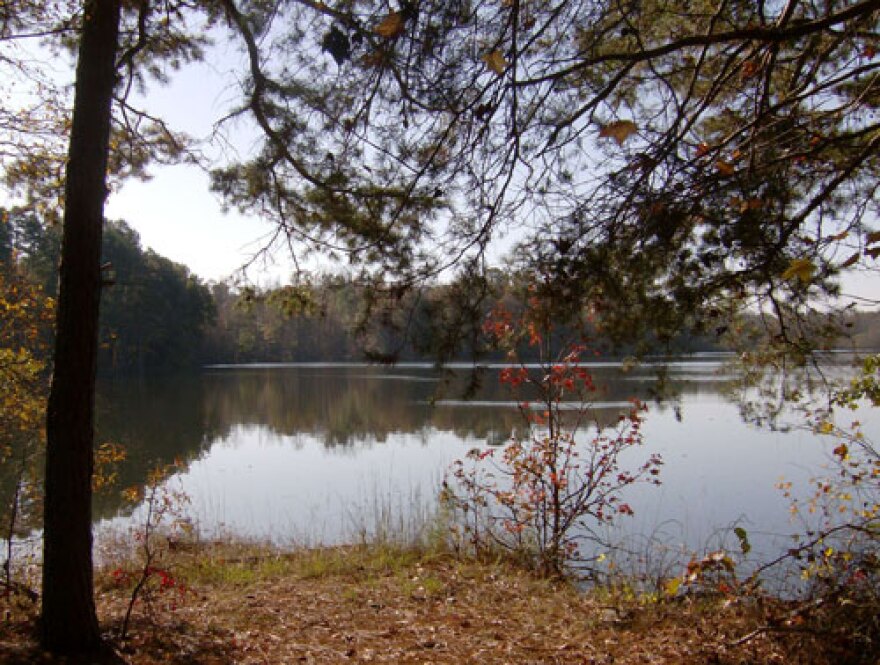http://66.225.205.104/JR20091112.mp3
It's been two and a half weeks since thousands of dead fish washed up on the shores of a small, isolated cove near the south end of High Rock Lake. And it's been about two and a half months since the town of Thomasville accidentally released 16 million gallons of raw sewage in the lake. State officials say the two events aren't directly linked. But they paint a picture of pollution problems that plague High Rock Lake on the Yadkin River. WFAE's Julie Rose reports:
The easiest way to find the cove where all the fish died on High Rock Lake is to look for the big birds circling over head. A big flock of them flies off as we walk to the water's edge. They've done a pretty good job . . . nothing but slimy little fish skeletons left and still some white fish bellies floating in the water. A big fish covered in maggots makes us back away.
The small cove is surrounded by trailers and modest homes. Lori Propst has lived here for 10 years. "It concerns me because my children swim out here and stuff and you know, seein' all them dead fish, makes you wonder what's gonna happen to us if we get in there," says Propst. She's buying gas at the Tamarac Marina around the corner from the cove. The locals come here to swap fish stories and fill up on the huge homemade breakfast special: Two eggs, bacon or sausage, grits or rice and gravy, toast or biscuits for $3.99.
The breakfast crowd has been buzzing about the fish kill. Technically, the state Division of Water Quality says the lake is safe for swimming and fishing. And to look at it, you wouldn't know it's polluted. But Dean Naujoks says the lake's appearance is deceiving. "Just because you can't see garbage floating in the water, a big plume of industrial effluent going into a river system doesn't mean there isn't serious pollution problems," says Naujoks. He's the Yadkin Riverkeeper.
The problem in High Rock Lake is called "nutrient pollution." Which sounds weird, since we usually think of nutrients as a good thing. "Well, nutrients are a good thing, if they're not in excess," says Naujoks. "The nutrients in this case are nitrogen and phosphorous." And where does it come from? Well, if you've ever gone swimming in High Rock Lake, you're not going to like this. "Nitrogen and phosphorous is in leftover waste water after sewage treatment plants discharge it into our rivers and streams," says Naujoks.
There are more than a hundred sewer treatment plants releasing more than a hundred million gallons of treated wastewater every day in streams that flow into High Rock Lake. In fact, most of North Carolina's rivers and reservoirs flow with treated wastewater. But High Rock Lake captures more pollution than most because its watershed is huge - nearly 4,000 square miles. That's a lot of flushing toilets. And nitrogen and phosphorous also come from the pet waste and fertilizer that run off farms and people's lawns when it rains. It goes into streams and rivers and is eventually trapped by the dam in High Rock Lake where Naujoks says it does exactly what you'd expect fertilizer to do.
"It helps grass grow, it helps crops grow," says Naujoks. "When you add it to water it explodes in the water, causes algae to grow at a tremendous rate which then depletes the water of oxygen and as the algae dies it further depletes the water of oxygen and can cause fish kills."
The state saw a sharp increase in reported fish kills last year, with more than twice the number as in 2007. Nutrient pollution was the underlying cause. Last year the state compiled a list of all the portions of streams, rivers and lakes in North Carolina that exceed Federal Clean Water pollution levels. It goes on for 96 pages and includes every river basin in central and eastern North Carolina. Part of the problem is that North Carolina doesn't have a statewide limit on nitrogen and phosphorous. Those rules are made lake-by-lake - usually only after pollution has become a major problem. High Rock Lake has finally reached that point, and the Division of Water Quality is near the end of a two-year water-testing program.
"It began in April 2008," says Kathy Stecker. She's supervising the High Rock Lake study for the Division of Water Quality. "And I want to emphasize that this was intensive monitoring. There had been monitoring going on all along. But this is monitoring every other week." They're trying to figure out who the biggest polluters are. That's going to take another year or two, followed by lots of wrangling with cities and farmers to set limits on nitrogen and phosphorous. And when all of that's finished, it'll be on to the next lake or river on that 96-page list. But there's also no guarantee the fix will protect High Rock Lake forever. Take Lake Wylie near Charlotte. It went through the nutrient management process in the 1990s and guess what? It's back on the list.

